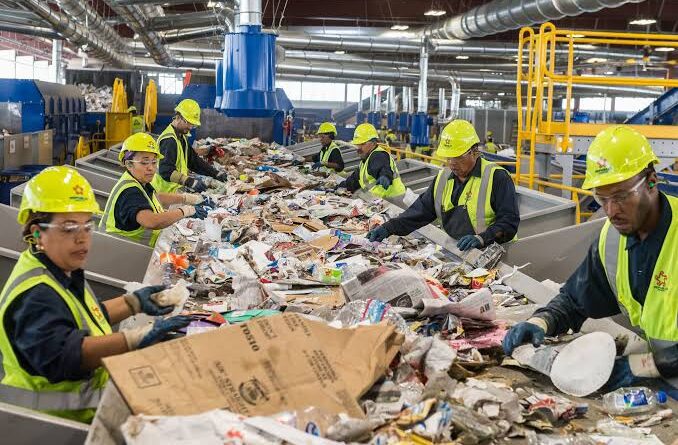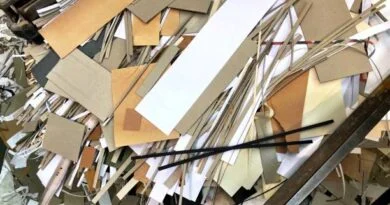Recycling Centers: A Step-by-Step Guide
A recycling center is a facility where materials that can be recycled are collected, sorted, processed, and then sent off to be reused. These centers play a crucial role in managing waste and protecting the environment. They help reduce the amount of waste that ends up in landfills, conserve natural resources, and reduce pollution.
Recycling centers are designed to handle a variety of materials. Common items accepted at these centers include paper, cardboard, glass, plastic, and metal. Some centers also accept electronics, batteries, and other special types of waste. Each type of material has its own process for recycling, and centers are equipped to handle the specific needs of each type.
When you visit a recycling center, the first step is usually to sort your items. Different bins or areas are designated for different materials. For example, there might be separate bins for paper, glass, and plastic. Sorting helps ensure that the materials can be processed correctly and efficiently.
Once the materials are sorted, they are prepared for processing. Paper and cardboard are often shredded and baled before being sent to paper mills where they are turned into new paper products. Glass is cleaned, crushed, and melted down to create new glass items. Plastic is sorted by type, cleaned, and then melted to be formed into new plastic products. Metals are also sorted, cleaned, and melted to be used in the manufacturing of new metal items.
Recycling centers not only help reduce waste but also conserve natural resources. By recycling paper, we save trees and reduce the need for new paper production. Recycling glass reduces the need for raw materials like sand and limestone. Recycling metals saves energy and reduces the need to mine for new ores. Plastic recycling helps reduce the demand for new plastic production, which in turn reduces the consumption of petroleum and natural gas.
In addition to conserving resources, recycling centers help reduce pollution. Manufacturing products from recycled materials typically requires less energy than producing them from new materials, which means fewer greenhouse gas emissions. Recycling also reduces the amount of waste that ends up in landfills, which can produce methane, a potent greenhouse gas. Furthermore, recycling helps prevent pollution from the extraction and processing of raw materials.
Recycling centers are often community-based and rely on the participation of local residents. Many centers offer educational programs to teach people about the importance of recycling and how to recycle properly. These programs might include school visits, workshops, and informational materials. By educating the community, recycling centers help ensure that more people participate in recycling efforts and do so correctly.
Another important aspect of recycling centers is the economic benefit they provide. Recycling creates jobs in the collection, sorting, and processing of materials. It also supports industries that use recycled materials to make new products. This can help boost local economies and provide employment opportunities.
Many recycling centers also engage in partnerships with businesses and municipalities to increase recycling rates. Businesses might set up recycling programs within their operations, and municipalities might provide curbside recycling services to residents. These partnerships help ensure that more materials are diverted from landfills and recycled instead.
Recycling centers are constantly evolving to handle new types of materials and improve their processes. Technological advancements are helping make recycling more efficient and effective. For example, new sorting technologies can better separate different types of plastics, and advanced processing techniques can turn recycled materials into high-quality products.
However, recycling centers also face challenges. Contamination is a major issue, as items that are not properly cleaned or sorted can ruin batches of recyclable materials. Public awareness and education are crucial in addressing this problem. Additionally, market fluctuations can impact the demand for recycled materials, which can affect the financial stability of recycling centers.
Despite these challenges, recycling centers remain a vital part of waste management and environmental conservation. They provide a way for individuals and communities to contribute to a healthier planet. By recycling, we can help reduce waste, conserve resources, and protect the environment for future generations.
Recycling centers are designed to handle a variety of materials. Common items accepted at these centers include paper, cardboard, glass, plastic, and metal. Some centers also accept electronics, batteries, and other special types of waste.
Each type of material has its own process for recycling, and centers are equipped to handle the specific needs of each type. For instance, at facilities like 185 Recycling, A and A Recycling, A and S Recycling, AAA Recycling, ABQ Recycling, and ABS Recycling, the focus is on efficient and effective processing of various materials to ensure maximum reuse and minimal environmental impact.
When you visit a recycling center, the first step is usually to sort your items. Different bins or areas are designated for different materials. For example, there might be separate bins for paper, glass, and plastic. Sorting helps ensure that the materials can be processed correctly and efficiently.
Once the materials are sorted, they are prepared for processing. Paper and cardboard are often shredded and baled before being sent to paper mills where they are turned into new paper products. Glass is cleaned, crushed, and melted down to create new glass items. Plastic is sorted by type, cleaned, and then melted to be formed into new plastic products. Metals are also sorted, cleaned, and melted to be used in the manufacturing of new metal items.
Recycling centers not only help reduce waste but also conserve natural resources. By recycling paper, we save trees and reduce the need for new paper production. Recycling glass reduces the need for raw materials like sand and limestone. Recycling metals saves energy and reduces the need to mine for new ores. Plastic recycling helps reduce the demand for new plastic production, which in turn reduces the consumption of petroleum and natural gas.
In addition to conserving resources, recycling centers help reduce pollution. Manufacturing products from recycled materials typically requires less energy than producing them from new materials, which means fewer greenhouse gas emissions. Recycling also reduces the amount of waste that ends up in landfills, which can produce methane, a potent greenhouse gas. Furthermore, recycling helps prevent pollution from the extraction and processing of raw materials.
Recycling centers like those mentioned earlier often play a pivotal role in their communities. For instance, centers such as ABQ Recycling and ABS Recycling engage with local residents to promote and facilitate recycling. These centers might offer educational programs to teach people about the importance of recycling and how to recycle properly. These programs might include school visits, workshops, and informational materials. By educating the community, recycling centers help ensure that more people participate in recycling efforts and do so correctly.
Another important aspect of recycling centers is the economic benefit they provide. Recycling creates jobs in the collection, sorting, and processing of materials. It also supports industries that use recycled materials to make new products. This can help boost local economies and provide employment opportunities.
Many recycling centers also engage in partnerships with businesses and municipalities to increase recycling rates. Businesses might set up recycling programs within their operations, and municipalities might provide curbside recycling services to residents. These partnerships help ensure that more materials are diverted from landfills and recycled instead.
Recycling centers are constantly evolving to handle new types of materials and improve their processes. Technological advancements are helping make recycling more efficient and effective. For example, new sorting technologies can better separate different types of plastics, and advanced processing techniques can turn recycled materials into high-quality products.
However, recycling centers also face challenges. Contamination is a major issue, as items that are not properly cleaned or sorted can ruin batches of recyclable materials. Public awareness and education are crucial in addressing this problem. Additionally, market fluctuations can impact the demand for recycled materials, which can affect the financial stability of recycling centers.
Despite these challenges, recycling centers remain a vital part of waste management and environmental conservation. They provide a way for individuals and communities to contribute to a healthier planet. By recycling, we can help reduce waste, conserve resources, and protect the environment for future generations.
Recycling centers are essential facilities that collect, sort, and process recyclable materials. They help reduce waste, conserve natural resources, reduce pollution, provide economic benefits, and educate the community. While they face challenges, the continued evolution and improvement of recycling centers ensure that they remain a key component of sustainable waste management and environmental protection.
Facilities like 185 Recycling, A and A Recycling, A and S Recycling, AAA Recycling, ABQ Recycling, and ABS Recycling exemplify the critical role these centers play in promoting environmental sustainability and community engagement.
Read Also: Cost of Starting a Waste Management Business
Aims/Purpose of Recycling Centers

Recycling centers serve several crucial aims and purposes, all of which contribute to environmental sustainability, resource conservation, and community well-being.
1. Reducing Waste: The primary aim of recycling centers is to reduce the amount of waste that ends up in landfills. By collecting, sorting, and processing recyclable materials, these centers significantly decrease the volume of trash that contributes to landfill overcrowding and environmental degradation.
2. Conserving Natural Resources: Recycling centers help conserve natural resources by reprocessing materials that have already been used. For instance, recycling paper reduces the need for deforestation, and recycling metals reduces the need for mining new ores. This conservation effort helps preserve ecosystems and biodiversity.
3. Reducing Pollution: Recycling centers contribute to pollution reduction by decreasing the need for raw material extraction and processing, which often involve harmful environmental practices. Recycling typically uses less energy and results in fewer emissions than producing new products from virgin materials, leading to lower air and water pollution levels.
4. Energy Conservation: Producing goods from recycled materials generally requires less energy than producing them from new, raw materials. For example, recycling aluminum saves up to 95% of the energy needed to produce new aluminum from bauxite ore. This energy savings reduces greenhouse gas emissions and helps combat climate change.
5. Economic Benefits: Recycling centers create jobs in the collection, sorting, and processing of recyclable materials. They also support industries that manufacture products from recycled materials, thereby contributing to local and global economies. By fostering a circular economy, recycling centers help reduce the economic impact of resource depletion.
6. Promoting Environmental Awareness: Recycling centers often engage in community education and outreach to raise awareness about the importance of recycling. They provide information on how to recycle properly, the benefits of recycling, and how individuals and businesses can contribute to sustainability efforts. This education fosters a culture of environmental responsibility.
7. Resource Efficiency: By efficiently managing the lifecycle of products, recycling centers promote the sustainable use of resources. They ensure that materials are reused and recycled rather than discarded, maximizing the utility and lifespan of resources and minimizing waste.
8. Supporting Regulatory Compliance: Recycling centers help communities and businesses comply with environmental regulations and waste management laws. By providing a structured system for recycling, they ensure that waste is handled in a manner that meets legal standards and supports broader environmental goals.
9. Encouraging Sustainable Practices: Recycling centers encourage individuals, businesses, and municipalities to adopt more sustainable practices. They highlight the importance of reducing, reusing, and recycling as key components of a sustainable lifestyle and operational strategy.
10. Enhancing Community Health: By reducing pollution and conserving natural resources, recycling centers contribute to healthier communities. Cleaner air, water, and soil lead to better public health outcomes, reducing the incidence of diseases linked to environmental pollution.
11. Innovation and Technological Advancement: Recycling centers drive innovation by developing and adopting new technologies and methods for recycling materials more efficiently. This continuous improvement helps address challenges such as contamination and market fluctuations, ensuring the recycling process becomes more effective over time.
12. Mitigating Climate Change: Through energy savings and reduced greenhouse gas emissions, recycling centers play a role in mitigating climate change. By promoting the use of recycled materials, they help decrease the carbon footprint associated with the production and disposal of goods.
Recycling centers aim to create a sustainable future by reducing waste, conserving resources, reducing pollution, conserving energy, providing economic benefits, promoting environmental awareness, ensuring resource efficiency, supporting regulatory compliance, encouraging sustainable practices, enhancing community health, driving innovation, and mitigating climate change.
By achieving these goals, facilities like 185 Recycling, A and A Recycling, A and S Recycling, AAA Recycling, ABQ Recycling, and ABS Recycling make significant contributions to environmental sustainability and community well-being.
Read Also: Waste to Energy Business: What You Need to Know
Where to Find or Locate Recycling Centers near Me/You

Finding or locating recycling centers is an important step in participating in recycling efforts and contributing to environmental sustainability. Here are some effective ways to find recycling centers in your area:
1. Online Search Engines: Using search engines like Google or Bing is a quick way to find recycling centers near you. Simply type in keywords like “recycling center near me” or specify your location, such as “recycling center in [your city].” This will provide you with a list of nearby centers along with their contact information and operating hours.
2. Local Government Websites: Many local government websites have sections dedicated to waste management and recycling services. These websites often provide detailed information about local recycling centers, including their locations, hours of operation, and the types of materials they accept. For example, municipal websites for cities like Albuquerque (for ABQ Recycling) often list local recycling facilities and services.
3. Waste Management Companies: Companies that provide waste management services, such as Waste Management Inc., Republic Services, or smaller regional companies, typically offer recycling services and can direct you to their nearest recycling centers. Their websites usually have tools to help you find the closest facility.
4. Recycling Apps and Websites: Several apps and websites are designed specifically to help people locate recycling centers. Examples include Earth911, Recycle Nation, and iRecycle. These platforms allow users to enter their location and find nearby recycling facilities, along with information on what materials each center accepts.
5. Community Centers and Local Organizations: Community centers, local environmental organizations, and non-profits often have information about recycling resources. They may offer guides, brochures, or online resources to help residents locate nearby recycling centers. Organizations such as AAA Recycling, ABS Recycling, and similar community-based facilities often collaborate with local groups to provide accessible recycling options.
6. Retail Stores and Supermarkets: Some retail stores and supermarkets have recycling programs and may accept certain items like plastic bags, batteries, and electronics. They can often provide information on where you can take other recyclable materials. Stores like Home Depot, Best Buy, and certain grocery chains often have drop-off points for specific recyclable items.
7. Local Recycling Events: Municipalities and community organizations sometimes host recycling events where residents can bring materials that are not typically collected curbside. These events can be a good way to recycle items like electronics, hazardous materials, and bulk items. Check local event listings or community bulletins for information.
8. Social Media and Online Communities: Platforms like Facebook, Nextdoor, and local forums can be useful for finding recommendations and information about recycling centers. You can ask community members for suggestions and get first-hand advice on where to go.
9. Phone Directories: Traditional phone directories and Yellow Pages still list recycling centers and waste management services. These can be useful for finding contact information and locations of local facilities.
10. Ask Local Authorities: Contacting your local city hall, public works department, or waste management authority directly can provide you with accurate and up-to-date information on where to recycle various materials in your area.
By using these resources, you can locate recycling centers that meet your needs and contribute to a sustainable environment. Whether you’re looking for comprehensive facilities like 185 Recycling, A and A Recycling, A and S Recycling, or specialized centers like ABQ Recycling and ABS Recycling, these methods will help you find the right place to recycle your materials responsibly.
Read Also: Short Hair Cat Breeds Description and Complete Care Guide




